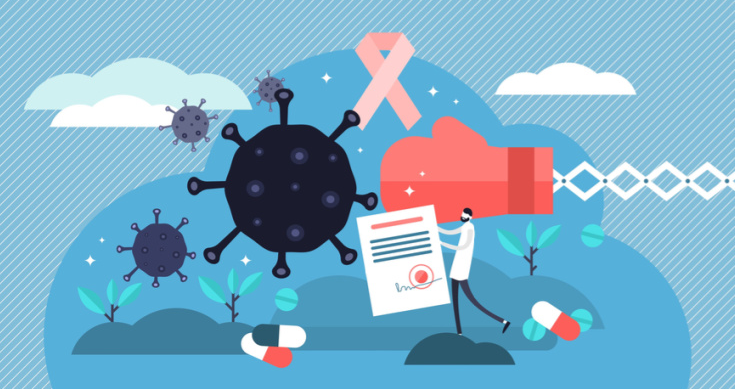by Alex Cook
Less than a year since COVID-19 began to run riot across the globe, causing upheaval to almost every facet of life, vaccines have been developed and approved for use by health authorities in Australia and in other countries. In previous BetaShares Insights articles, we looked at the role of robotics and artificial intelligence (A.I.) in fighting the spread of COVID-19, along with a deep dive into specific companies and their role in combating the pandemic.
In this piece, we examine the role robotics and A.I. have played not only in developing a vaccine but also in its distribution. We also touch on other areas A.I. has been used in managing the effects of the pandemic, highlighting its future importance outside the healthcare sector.
Vaccine development
Throughout 2020, robotics made headlines for its role in disinfecting hospital corridors, helping nurses manage routine tasks and delivering meals to people in self-isolation. Now, robotics is making headlines for its role in the development of COVID-19 vaccines. Leading global technology company ABB (which currently has a ~7% weight in the BetaShares Global Robotics and Artificial Intelligence ETF (ASX:RBTZ)) has developed a collaborative robot (pictured below) capable of assisting with key tasks in the development and testing of a COVID-19 vaccine1.

ABB’s YuMi Robot handles the complete human immune neutralisation testing process, mixing and testing samples of the COVID-19 virus with different antibodies to create a vaccination formula.
A.I., as discussed in previous blogs, was used to determine the potential path COVID-19 may take2. In terms of vaccine development, A.I. has also been used to determine the effectiveness of the formula developed by robots3. It has done this by analysing the virus’s protein structure, virulence and other chemical compounds. This has assisted scientists and healthcare professionals in accelerating the preparation of the vaccine and determining which vaccine is the most effective4.
Vaccine distribution
Distribution of the COVID-19 vaccine is arguably the most complex healthcare distribution activity in history. This is due mainly to the billions of people who are looking to receive it, the importance of flexibility to ensure it can be distributed to the areas that need it, and because of some of the vaccines’ dependence on temperature control (for example, Pfizer’s vaccine requires a -70 degrees Celsius cold chain to be maintained up to the point of vaccination).
Due to these challenges, some distributors are turning to A.I. and RPA (Robotic Process Automation – the act of robots emulating the actions of a human interacting within digital systems)5.
RPA has the potential to increase efficiency in health care organisations and supply chains “overwhelmed by the challenges of COVID-19 vaccine management”6.
An example of how this works is on the transport and temperature management side. It is proposed that RPA, along with specific sensor tags, could be used to continually measure the temperature of vaccine batches and send that data via Bluetooth to smart devices to manage distribution, and control spoiled vaccines (as highlighted by the infographic below)7.
From sensor to driver: RPA bots automatically trigger a pre-defined set of actions to help manage the distribution of the COVID-19 vaccine.
On the physical delivery side, to ensure speed, overcome logistic hurdles and minimise human contact, unmanned aircraft and drones are being prepped to deliver COVID-19 vaccines8. Further, industry-leading automation solutions provider ATS Automation Tooling Systems Inc (which currently has a ~2% weight in RBTZ) has received a contract to “design, build, and deliver several automated safety syringes to meet potential demand related to COVID-19 vaccine production”9.
Broader uses of A.I. in combating COVID-19
Outside of its importance in developing and distributing the vaccine, A.I. has also assisted in managing the broader effects of the pandemic.
In the utility sector, A.I. was utilised to help manage power load forecasting and determine power consumption levels, which shifted greatly due to city-wide lockdowns and global mobility restrictions10. Charities, health organisations and supply companies also used A.I. to optimise resource allocation during the pandemic. A.I. has also shown its potential in fighting misinformation, with social networks and search using A.I. algorithms to find and remove misleading COVID-19 material11.
Another notable example of A.I. use in managing the effects of the pandemic was seen in the oil market. After fuel demand crashed and caused the price of oil futures to go negative in April 2020, machine learningi was utilised to help build models to project the ongoing impact of lockdowns and lower U.S. medium-term gasoline demand12.
i. Machine Learning: The process of teaching a computer system how to make accurate predictions.
A permanent A.I. and robotics response
The global response to the pandemic has been nothing short of extraordinary, and the development of the vaccine just as impressive. While the speedy development of the COVID-19 vaccine was helped by prior knowledge of coronaviruses, record funding and a global collaborative effort, it was also boosted by A.I. The fields of robotics, A.I. and machine learning have long been called on in combating diseases13, and their success in assisting in the development of COVID-19 vaccines and in helping to overcome the distribution obstacles highlights the ongoing importance of the thematic.
Investors wishing to gain exposure to this trend can consider the BetaShares Global Robotics and Artificial Intelligence ETF (ASX: RBTZ), which provides a convenient and cost-effective way to invest in many of the leading companies expected to benefit from the increased adoption and utilisation of Robotics and A.I now and in the future.
RBTZ has generated a return of 17.4% p.a. from inception in September 2018 to 31 January 2021. Over the 12 months to 31 January 2021, RBTZ returned 36.1%14.
ENDPOINTS
1. https://new.abb.com/news/detail/72021/abb-robots-accelerate-covid-19-vaccine-development-in-thailand
2. https://www.mja.com.au/journal/2020/can-ai-help-fight-against-covid-19
3. https://sites.kowsarpub.com/archcid/articles/103232.html
4. https://www.afr.com/technology/ai-suggests-australia-may-have-backed-a-covid-19-vaccine-winner-20200908-p55thy
5. https://www.uipath.com/rpa/robotic-process-automation
6. https://venturebeat.com/2020/12/27/how-rpa-could-help-distribute-and-track-covid-19-vaccines/
7. https://itelligencegroup.com/my/global-blog/safer-more-efficient-cold-chain-management-with-rpa/
8. https://www.cnbcafrica.com/2021/nigerias-kaduna-pairs-with-zipline-for-drone-delivered-covid-vaccines/
9. https://www.newswire.ca/news-releases/ats-receives-order-for-covid-19-vaccine-syringe-manufacturing-line-introduces-symphoni-tm–895619331.html
10. https://www.ncbi.nlm.nih.gov/pmc/articles/PMC7532790/
11. https://www.oecd.org/coronavirus/policy-responses/using-artificial-intelligence-to-help-combat-covid-19-ae4c5c21/
12. https://www.ncbi.nlm.nih.gov/pmc/articles/PMC7543031/
13. https://www.frontiersin.org/articles/10.3389/frai.2020.00065/full
14. Past performance is not an indicator of future performance.









